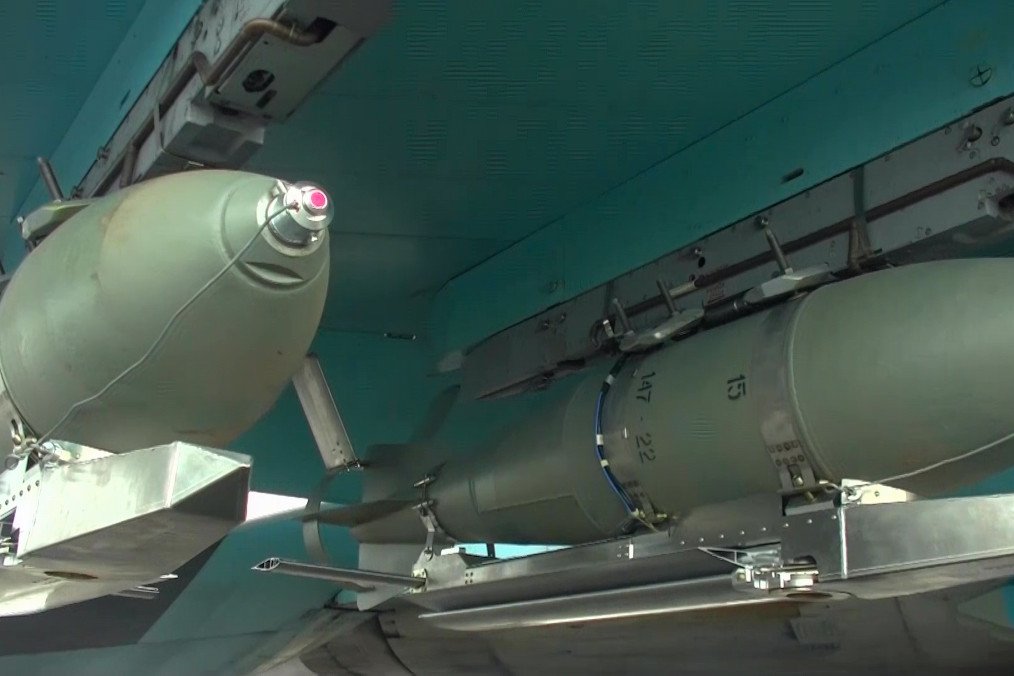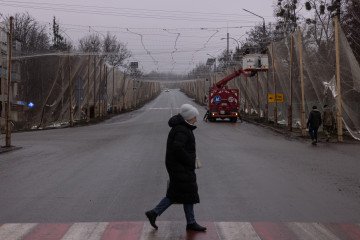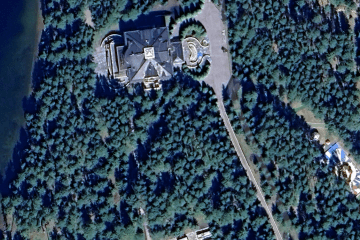Russia has been continuously using glide bombs against civilians, infrastructure, the military, and their positions in Ukraine. In the last month alone, it launched two FAB variants that had never been seen before in the war. What are they, and how can Ukraine defeat them?
Ukraine is being terrorized by glide bombs; they're cheap but highly destructive, and now, for the first time since the full-scale invasion began in 2022, the front is being targeted by the FAB 500-T and FAB-3000 M-54 variants.
Glide bombs have become one of Russia’s main tools of aggression and a key tactic in their attempt to seize Ukrainian territory. Zelenskyy said that Russia had used more than 800 powerful glide bombs on Ukraine during the last week of June alone.
The FAB 500-T is not a new bomb but a rare one. No longer a ‘Soviet legacy,’ it’s back in production, striking targets in Kharkiv. The FAB-3000 M-54 is the largest of its kind, but is it effective? What glide bombs are being used against Ukraine, and how? Are they effective, and how can Ukraine defeat them?
Recent strikes
“There are no words to describe the aftermath of a glide bomb attack," said Vovchansk police chief Oleksii Kharkivsky. "You arrive to see people who are lying there, torn apart.”
Kharkiv has faced heavy glide bomb strikes. This police officer’s body cam footage captures the moment of a recent strike against civilian infrastructure in the city. More recent attacks include one on Nova Poshta, a Ukrainian postal service depot, that was hit with an FAB 500 on June 30th. On July 2, Russia again used FAB-500 aerial bombs against the city.
These are just a few examples of thousands of glide bombs sent to kill Ukrainian civilians across the country.
What are glide bombs?
An aerial bomb is a type of explosive or incendiary weapon intended to travel through the air. An un-guided aerial bomb is also known as a ‘dumb bomb,’ and a guided bomb is known as a ‘smart bomb.’
A glide bomb is a ‘smart bomb’ as it is guided by satellite navigation. It has wings attached to it that can be corrected in response to commands, making the bomb glide to its target—rather than fall like ‘dumb bombs,’ which are dropped to fall on target.
Since 2023, Russia has been attaching a simple conversion kit called the UMPK (unified gliding and correction module). It converts the free-falling ‘dumb bomb’ to a glide bomb. However, according to IISS, images circulated via social media in early March of this year show that Russia has now developed more of an “integrated design” rather than using the conversion kit.
Ukrainians have “practically no countermeasures” as glide bombs can be released outside of range and FAB bombs can glide up to around 80 km. Russian forces can keep their Su-34 and Su-35 jets—which launch the FABs—inside Russian territory. They can launch bombs from within their own airspace. As of yet, Ukraine lacks the long-range missiles to strike back. This helps Russia keep its bombs, pilots, and aircraft safe from Ukraine’s air-defenses.
Glide bombs are an increasingly popular weapon in Russia's arsenal and have only recently been used en masse. They have become a key tactic in attempting to seize Ukrainian territory and were pivotal in February’s capture of the once heavily fortified city of Avdiivka, according to The Centre for European Policy Analysis (CEPA).
According to the Institute For The Study of War (ISW), Russian forces launched 60 KAB glide bombs and 250 FAB bombs at Ukrainian positions in Avdiivka on Feb 17th alone. Russian forces likely used this air superiority to support their capture of the city.
“Delays in Western security assistance may lead to further significant constraints on Ukrainian air defenses that could allow Russian forces to replicate the air support that facilitated Russian advances in Avdiivka at scale in Ukraine,” said ISW.
What glide bombs is Russia using?
During the last week of June, Russians used two rare FAB 500-T glide bombs against Kharkiv, the first time since the full-scale invasion began. One hit a residential house in a village within the region and the other in the city itself; luckily, neither detonated.
"It is twice as powerful as the KAB and FAB-250 previously used to bomb Kharkiv daily," noted Oleksandr Filchakov, head of the regional prosecutor's office. Filchakov stated that two aerial bombs were launched from a Su-34 aircraft from Mayak in the Belgorod region, flying 65 km from the launch site to the impact site.
KAB is a laser-guided bomb whose name stands for “Managed (corrected) aircraft bomb.” On May 25th, 2024, a hypermarket in Ukraine was hit with two KABs. According to the General Staff of the Armed Forces of Ukraine, 40 guided aerial bombs were used against Ukraine on this day alone.
FAB-250 stands for “High-Explosive Aviation Bombs.” Their explosive material constitutes approximately 50% of the bomb's total weight, which in this case is 250 kg.
Russian forces have routinely used the FAB-500M62 with a UMPK modification. This variant
has an explosive weight of 300kg, whereas the FAB 500-T variant’s is only 260kg. With its lower weight and with an added external design, it makes it far more aerodynamic than the FAB variants we’ve seen used before. Therefore it can travel further.
The ‘T’ in FAB 500-T indicates “heat resistant.” This type of bomb is made to endure thermal stresses associated with its usual carrier aircraft—the powerful Mig-25RB—with ejection speeds of around 2500 km per hour, making it difficult to intercept.
How reliable are Russia’s glide bombs?
The largest type of precision-guided weapon in Russia’s arsenal is the FAB-3000 M-54. On June 20th, Russia reportedly dropped the first FAB-3000 M-54 UMPK, which has a 3-ton heavy bomb—1.2 tons warhead—on Lyptsy, Kharkiv region. This is the first time a bomb of this size has been recorded.
The bomb was off target, but the consequences were still serious, spreading its shrapnel more than half a mile away. Sukhoi Su-34 fighter-bomber launched the bomb, according to Fighterbomber, a popular Russian Telegram channel. It claimed that although it missed its target, it was an “excellent result.”
The Su-34 can carry three FAB-1500s which are more aerodynamic and are more precise. “The power of the FAB-3000 is only slightly greater than the power of the FAB-1500,” Fighterbomber explained. Some speculate that using this kind of bomb is mainly for propaganda purposes rather than effectiveness.
Russia’s “great tool”—the glide bomb—has also been falling on its own territory, an internal Russian document by the Washington Post revealed. “At least 38 of the bombs, which have been credited with helping drive Russia’s recent territorial advances, crashed into the Belgorod region on the border with Ukraine between April 2023 and April 2024. Though most did not detonate”.
However, one of the first recorded to hit Belgorod in 2023—created a 65 ft wide crater. The document later confirmed it was FAB-500. According to the document, “another bomb fell on Belgorod, injuring seven people and damaging more than 30 houses.”
On May 12, another accidental FAB-500 bombing, or what could have been a rogue Russian anti-aircraft missile, destroyed an apartment block in Belgorod, killing 17 people, according to Conflict Intelligence Team, a Russian research group specializing in open-source investigations.
“A certain percentage of Russian bombs are defective. This problem has existed since they started using these UMPK kits, and it’s not being fundamentally solved. We think these accidental releases are caused by the unreliability of these kits, something that does not seem to bother the Air Force,” Ruslan Leviev, a military expert with the Conflict Intelligence Group, said. “Unlike Western high-precision bombs, the UMPK kits are produced relatively cheaply and in large quantities, using civilian electronics, where reliability requirements are much lower.”
Though sometimes unreliable, thousands are still successfully destroying civilian infrastructure in Ukraine.
How can Ukraine defeat them?
"They would sooner give up bread, butter, and so forth, but not bombs. Expanding their quantity is an existential path for Russia. They will always manufacture bombs, so the means of countering them must be to neutralize the means of delivery overall," said Valerii Romaneko, an aviation expert.
At the end of May 2024, Western allies untied Ukrainian hands by lifting restrictions on the use of their weapons against military targets on Russian territory. However, The USA has not allowed Ukraine to use long-range ATACMS within Russian territory. Ukraine is still waiting for more Western weapons and calls for more patriot systems.
Glide bombs are difficult to detect on radar and do not emit detectible heat. The best way to deter glide bomb attacks is to eliminate their aircraft carriers, as the bombs are difficult to intercept. The most obvious way to counteract these attacks is to bolster Ukraine’s air-defense.
“It’s extremely important to get Western fighters that will allow us to strike the aircraft carrying these kinds of bombs much earlier, and receiving Western long-range air-to-air missiles will make it possible to drive away enemy aircraft from the front-line zone,” said Oleh Katkov of Defense Express.
“If we had these modern Patriot systems, (Russian) airplanes wouldn’t be able to fly close enough to drop the (glide) bombs on the civilian population and the military,” said Zelenskyy.
It seems that Russia will keep producing, manufacturing, and launching glide bombs until the sufficient delivery of Western long-range weapons arrives, allowing Ukraine to eliminate the military targets waging war against the country.
-46f6afa2f66d31ff3df8ea1a8f5524ec.jpg)


-f88628fa403b11af0b72ec7b062ce954.jpeg)
-b63fc610dd4af1b737643522d6baf184.jpg)


-29a1a43aba23f9bb779a1ac8b98d2121.jpeg)

-24deccd511006ba79cfc4d798c6c2ef5.jpeg)